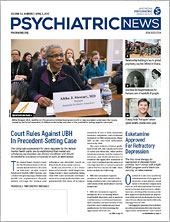Provider reimbursement and “network adequacy”—having enough mental health professionals in a health plan network who are available to provide care—is critical to expanding access to care for mental illness and substance use disorders.
That’s what APA and other medical leaders agreed during a panel discussion in February hosted by the New York Academy of Medicine, the New York County Psychiatric Society, and the New York State Psychiatric Association (NYSPA). Jeffrey Borenstein, M.D., chair of the academy’s Section on Psychiatry, president and CEO of the Brain and Behavior Research Foundation, and editor-in-chief of Psychiatric News, served as moderator.
APA President-elect Bruce Schwartz, M.D., and Henry Harbin, M.D., a past director of the State Mental Health Authority for Maryland, cited the 2017 report by Milliman Inc. titled “Addiction and Mental Health vs. Physical Health: Analyzing Disparities in Network Use and Provider Reimbursement Rates,” which found significant disparities in out-of-network utilization levels for inpatient, outpatient, and office visits for behavioral health care compared with medical and surgical visits (
Psychiatric News, December 26, 2017).
Schwartz, who is a professor and deputy chair of the Department of Psychiatry and Behavioral Sciences at Montefiore Medical Center and Albert Einstein College of Medicine, noted that Aetna recently settled with the Massachusetts attorney general after an investigation found that the company violated state law because of inaccurate and deceptive provider directories and inadequate provider networks.
Schwartz also noted that in 2016, a team of researchers with the APA Foundation telephoned a randomly selected sample of psychiatrists publicly listed as network psychiatrists for the three largest health insurance carriers in Washington, D.C. They found that most of the network psychiatrists listed as practicing in the area either were not able to schedule an appointment or were not even reachable at the listed telephone numbers.
The analysis revealed that close to a quarter of the phone numbers for the listed psychiatrists were nonresponsive or were nonworking numbers. And only 15 percent of psychiatrists were able to schedule any appointment for callers; in one plan, only 4 percent were able to schedule an outpatient appointment (
Psychiatric News, June 10, 2016).
Schwartz said that the business community is a strong ally in improving access to behavioral health care given the high cost of not addressing these issues in productivity loss, lower employee retention, high rates of disability, and higher overall employee costs. “While employers are paying for benefits, they are not getting what they paid for when employees cannot access behavioral health care,” he said. “Businesses are well positioned to ask health plans for data on provider networks and to examine disparities to improve accountability.”
Rachel Fernbach, J.D., deputy director and assistant general counsel at the NYSPA, described federal and state parity noncompliance issues in New York related to nonquantifiable treatment limits (NQTLs) in two key areas: utilization review and reimbursement rates.
She said New York insurers are using medical necessity criteria to restrict coverage of visits and prior authorization as cost-cutting measures. Insurers are invoking “peer reviews” with health plans arranging for interviews with psychiatrists to ask why they are seeing patients so often.
“No one would tell cardiologists that they are seeing their patients too much, yet psychiatrists in New York are routinely asked to justify ongoing care,” Fernbach said.
The panel agreed these practices place undue administrative costs and burdens on psychiatrists in the state. At the same time, compensation provided for care is unreasonably low, causing psychiatrists to leave networks.
Schwartz remarked that payment disparities for mental health and substance use care are sometimes 50 percent to 60 percent less than what is paid to medical and surgical providers for comparable care. He also cited serious concerns with the national lack of psychiatric beds, causing people to be either denied admission or discharged early. Schwartz noted that for some patients “the shorter the length of stay, the higher the readmission rates.”
“These are bipartisan issues—red and blue political leaders are aware of these challenges and want to do something about it,” Schwartz said.
The presenters shared these developments and strategies that they are hopeful will improve access to care:
•
APA is working with 24 states and key federal regulators to educate them on key issues like high out-of-network utilization, low in-network participation, and payment differentials as major parity NQTL noncompliance red flags.
•
Multiple state insurance regulators are closely examining the network adequacy of behavioral health care plans and other NQTLs for potential parity noncompliance with support from APA and other key stakeholders.
•
State attorneys general are engaged in examining NQTLs in terms of their being potential parity violations and considering potential litigation with support from APA and other key stakeholders.
•
The National Alliance of Healthcare Purchaser Coalitions, an umbrella organization of business coalitions across the country, released an influential report in August 2018 titled “Achieving Value in Mental Health Support: A Deep Dive Powered by eValue8.” It examines the performance of health plans and behavioral health organizations in delivering care.
•
APA and the APA Foundation’s Center for Workplace Mental Health developed recommendations for improving access to mental health and substance use care that includes steps that employers and health plans should take to improve access to mental health and substance use care. The recommendations are featured in the National Alliance report, and APA and the APA Foundation are working with the National Alliance on strategies to operationalize the recommendations.
•
The National Alliance and the Center for Workplace Mental Health recommend that employers obtain quantitative assessments from third-party administrators on how well their employees are accessing mental health and substance use benefits. A Model Data Request Form was developed with support from the Bowman Family Foundation for employers to send to their third party administrators that sets out the data to be shared. ■
“Addiction and Mental Health vs. Physical Health: Analyzing Disparities In Network Use and Provider Reimbursement Rates” can be accessed
here. “Achieving Value in Mental Health Support: A Deep Dive Powered by eValue8” is available
here. “Recommendations for Improving Access to Mental Health and Substance Use Care” is posted
here. The Model Data Request Form is located
here.

